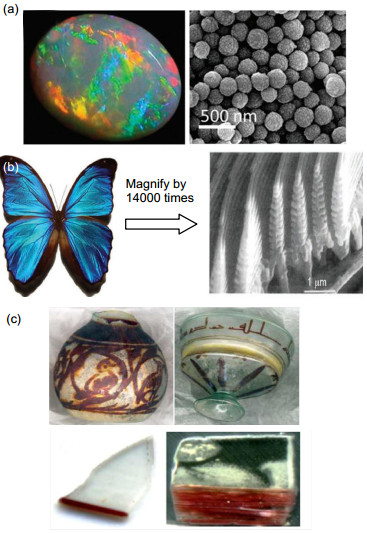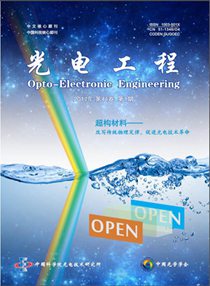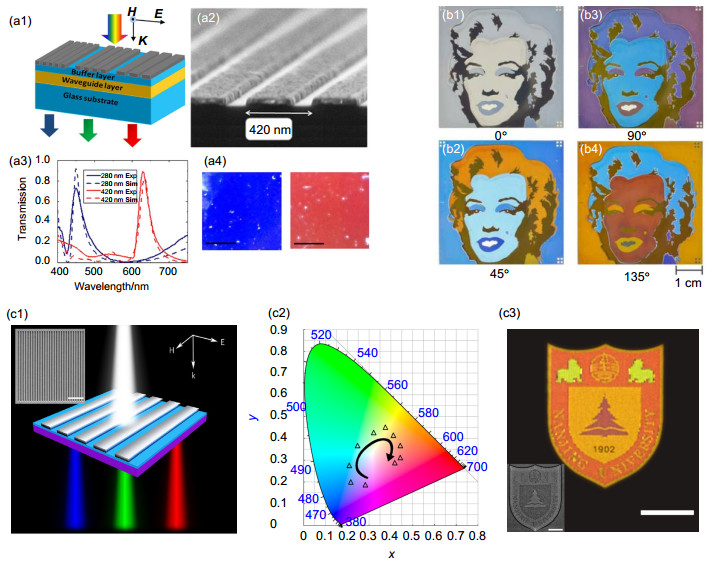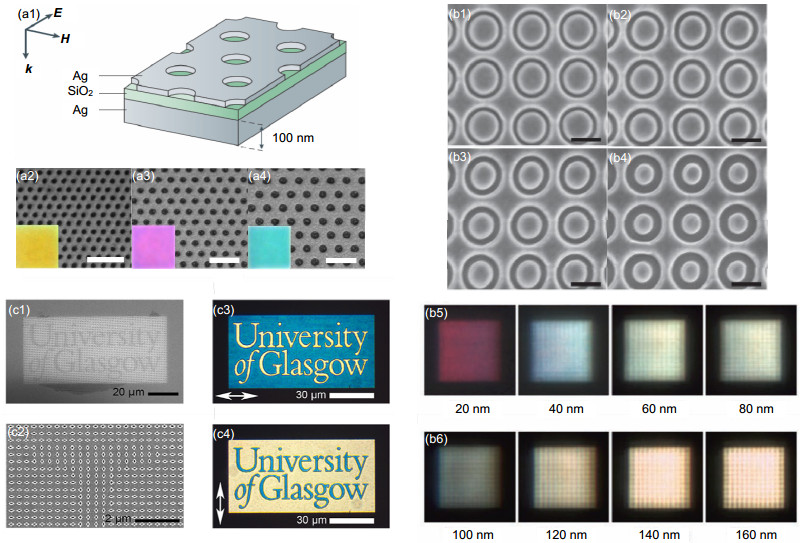| Citation: | Jiaxing Wang, Qingbin Fan, Hui Zhang, et al. Research progress in plasmonic structural colors[J]. Opto-Electronic Engineering, 2017, 44(1): 23-33. doi: 10.3969/j.issn.1003-501X.2017.01.002 |
Research progress in plasmonic structural colors
-
Abstract
Plasmonic structural colors originate from the interaction between light and metallic nanostructures. Rapid development in nanofabrication and characterization of plasmonic structures provides an efficient way to control light properties at subwavelength scale, which can generate plasmonic structural colors. Here we introduce several representative plasmonic nanostructures which can generate visible structural colors, including nanogratings, perforated metallic films, metal-insulator-metal resonators, dynamically tunable color generators and perfect absorbers. We highlight the properties of plasmonic colors and discuss the intrinsic plasmonic resonance mechanisms. Plasmonic structural colors have the advantages such as ultra-small patterns and rapid response of external change, which are believed to offer a promising future in high-resolution color displays and real-time colors controlling.-
Keywords:
- plasmonics /
- color filtering /
- nanofabrication /
- metallic nanostructures
-

-
References
[1] Armstrong E, O'Dwyer C. Artificial opal photonic crystals and inverse opal structures – fundamentals and applications from optics to energy storage[J]. Journal of Materials Chemistry, 2015, 3(24): 6109-6143. [2] Xu Ting, Shi Haofei, Wu Y K, et al. Structural colors: from plasmonic to carbon nanostructures[J]. Small, 2011, 7(22): 3128-3136. doi: 10.1002/smll.v7.22 [3] Padovani S, Puzzovio D, Sada C, et al. XAFS study of copper and silver nanoparticles in glazes of medieval middle-east lustreware (10th-13th century)[J]. Applied Physics A, 2006, 83(4): 521-528. doi: 10.1007/s00339-006-3558-4 [4] Colomban P. The use of metal nanoparticles to produce yellow, red and iridescent colour, from bronze age to present times in lustre pottery and glass: solid state chemistry, spectroscopy and nanostructure[J]. Journal of Nano Research, 2010, 8(27): 109-132. [5] Faraday M. The bakerian lecture: experimental relations of gold (and other metals) to light[J].Philosophical Transactions of the Royal Society of London, 1857, 147: 145-181. doi: 10.1098/rstl.1857.0011 [6] Mie G. Beiträge zur optik trüber medien, speziell kolloidaler metallüsungen[J]. Annalen Der Physik, 1908, 330(3): 377-445. doi: 10.1002/(ISSN)1521-3889 [7] Hedayati M K, Faupel F, Elbahri M. Review of plasmonic nanocomposite metamaterial absorber[J]. Materials, 2014, 7(2): 1221-1248. doi: 10.3390/ma7021221 [8] Murray W A, Barnes W L. Plasmonic materials[J]. Advanced Materials, 2007, 19(22): 3771-3782. doi: 10.1002/(ISSN)1521-4095 [9] Kildishev A V, Boltasseva A, Shalaev V M. Planar Photonics with Metasurfaces[J]. Science, 2013, 339(6125):1232009 doi: 10.1126/science.1232009 [10] Gu Yinghong, Zhang Lei, Yang J K W, et al. Color generation via subwavelength plasmonic nanostructures[J]. Nanoscale, 2015, 7(15): 6409-6419. doi: 10.1039/C5NR00578G [11] Al-Salem S M, Lettieri P, Baeyens J. Recycling and recovery routes of plastic solid waste (PSW): a review[J]. Waste Management, 2009, 29(10): 2625-2643. doi: 10.1016/j.wasman.2009.06.004 [12] Kumar K, Duan Huigao, Hegde R S, et al. Printing colour at the optical diffraction limit[J]. Nature Nanotechnology, 2012, 7(9): 557-561. doi: 10.1038/nnano.2012.128 [13] Roberts A S, Pors A, Albrektsen O, et al. Subwavelength plasmonic color printing protected for ambient use[J]. Nano Letters, 2014, 14(2): 783-787. doi: 10.1021/nl404129n [14] Tan S J, Zhang Lei, Zhu Di, et al. Plasmonic color palettes for photorealistic printing with aluminum nanostructures[J]. Nano Letters, 2014, 14(7): 4023-4029. doi: 10.1021/nl501460x [15] Lueder E. Liquid crystal displays: addressing schemes and electro-optical effects[M]. 2nd ed. New York: Wiley Publishing, 2010. [16] Singh R R, Ho D, Nilchi A, et al. A CMOS/thin-film fluorescence contact imaging microsystem for DNA analysis[J]. IEEE Transactions on Circuits and Systems I: Regular Papers, 2010, 57(5): 1029-1038. doi: 10.1109/TCSI.2010.2043990 [17] Yokogawa S, Burgos S P, Atwater H A. Plasmonic color filters for CMOS image sensor applications[J]. Nano Letters, 2012, 12(8): 4349-4354. doi: 10.1021/nl302110z [18] Cho Y, Choi Y K, Sohn S H. Optical properties of neodymium-containing polymethylmethacrylate films for the organic light emitting diode color filter[J]. Applied Physics Letters, 2006, 89(5): 051102. doi: 10.1063/1.2244042 [19] Xin J Z, Hui K C, Wang K, et al. Thermal tuning of surface plasmon resonance: Ag gratings on barium strontium titanate thin films[J]. Applied Physics A, 2012, 107(1): 101-107. doi: 10.1007/s00339-011-6742-0 [20] Ozbay E. Plasmonics: merging photonics and electronics at nanoscale dimensions[J]. Science, 2006, 311(5758): 189-193. doi: 10.1126/science.1114849 [21] Stockman M I. Nanoplasmonics: the physics behind the applications[J]. Physics Today, 2011, 64(2): 39-44. doi: 10.1063/1.3554315 [22] Arsenault A C, Míguez H, Kitaev V, et al. A polychromic, fast response metallopolymer gel photonic crystal with solvent and redox tunability: a step towards photonic ink (P-Ink)[J]. Advanced Materials, 2003, 15(6): 503-507. doi: 10.1002/adma.200390116 [23] Kim H, Ge Jianping, Kim J, et al. Structural colour printing using a magnetically tunable and lithographically fixable photonic crystal[J]. Nature Photonics, 2009, 3(9): 534-540. doi: 10.1038/nphoton.2009.141 [24] Cao Linyou, Fan Pengyu, Barnard E S, et al. Tuning the color of silicon nanostructures[J]. Nano Letters, 2010, 10(7): 2649-2654. doi: 10.1021/nl1013794 [25] Seo K, Wober M, Steinvurzel P, et al. Multicolored vertical silicon nanowires[J].Nano Letters, 2011, 11(4): 1851-1856. doi: 10.1021/nl200201b [26] Ritchie R H, Arakawa E T, Cowan J J, et al. Surface-plasmon resonance effect in grating diffraction[J]. Physical Review Letters, 1968, 21(22): 1530-1533. doi: 10.1103/PhysRevLett.21.1530 [27] Homola J, Koudela I, Yee S S. Surface plasmon resonance sensors based on diffraction gratings and prism couplers: sensitivity comparison[J]. Sensors and Actuators B: Chemical, 1999, 54(1-2): 16-24. doi: 10.1016/S0925-4005(98)00322-0 [28] Kaplan A F, Xu Ting, Guo L J. High efficiency resonance-based spectrum filters with tunable transmission bandwidth fabricated using nanoimprint lithography[J]. Applied Physics Letters, 2011, 99(14): 143111. doi: 10.1063/1.3647633 [29] Zeng Beibei, Gao Yongkang, Bartoli F J. Ultrathin nanostructured metals for highly transmissive plasmonic subtractive color filters[J]. Scientific Reports, 2013, 3: 2840. doi: 10.1038/srep02840 [30] Yoon Y T, Park C H, Lee S S. Highly efficient color filter incorporating a thin metal-dielectric resonant structure[J]. Applied Physics Express, 2012, 5(2): 022501. doi: 10.1143/APEX.5.022501 [31] Park C H, Yoon Y T, Shrestha V R, et al. Electrically tunable color filter based on a polarization-tailored nano-photonic dichroic resonator featuring an asymmetric subwavelength grating[J]. Optics Express, 2013, 21(23): 28783-28793. doi: 10.1364/OE.21.028783 [32] Honma H, Takahashi K, Fukuhara M, et al. Free-standing aluminium nanowire arrays for high-transmission plasmonic colour filters[J]. IET Micro & Nano Letters, 2014, 9(12): 891-895. [33] Shrestha V R, Lee S S, Kim E S, et al. Polarization-tuned dynamic color filters incorporating a dielectric-loaded aluminum nanowire array[J]. Scientific Reports, 2015, 5: 12450. doi: 10.1038/srep12450 [34] Ye M, Hu X L, Sun L B, et al. Duty cycle dependency of the optical transmission spectrum in an ultrathin nanostructured Ag film[J]. Journal of Alloys and Compounds, 2015, 621: 244-249. doi: 10.1016/j.jallcom.2014.09.202 [35] Kedawat G, Kumar P, Vijay Y K, et al. Fabrication of highly efficient resonant structure assisted ultrathin artificially stacked Ag/ZnS/Ag multilayer films for color filter applications[J]. Journal of Materials Chemistry C, 2015, 3(26): 6745-6754. doi: 10.1039/C5TC00678C [36] Duempelmann L, Luu-Dinh A, Gallinet B, et al. Four-fold color filter based on plasmonic phase retarder[J]. ACS Photonics, 2016, 3(2): 190-196. doi: 10.1021/acsphotonics.5b00604 [37] Kaplan A F, Xu Ting, Wu Y K, et al. Multilayer pattern transfer for plasmonic color filter applications[J]. Journal of Vacuum Science & Technology B, Nanotechnology and Microelectronics: Materials, Processing, Measurement, and Phenomena, 2010, 28(6): C6060-C6063. [38] Wang Jiaxing, Fan Qingbin, Zhang Si, et al. Ultra-thin plasmonic color filters incorporating free-standing resonant membrane waveguides with high transmission efficiency[J]. Applied Physics Letters, 2017, in press. [39] Ebbesen T W, Lezec H J, Ghaemi H F, et al. Extraordinary optical transmission through sub-wavelength hole arrays[J]. Nature, 1998, 391(6668): 667-669. doi: 10.1038/35570 [40] Ghaemi H F, Thio T, Grupp D E, et al. Surface plasmons enhance optical transmission through subwavelength holes[J]. Physical Review B, 1998, 58(11): 6779. doi: 10.1103/PhysRevB.58.6779 [41] Genet C, Ebbesen T W. Light in tiny holes[J]. Nature, 2007, 445(7123): 39-46. doi: 10.1038/nature05350 [42] Cheng F, Gao J, Luk T S, et al. Structural color printing based on plasmonic metasurfaces of perfect light absorption[J]. Scientific Reports, 2015, 5:11045. doi: 10.1038/srep11045 [43] Liu Y J, Si G Y, Leong E S, et al. Light-driven plasmonic color filters by overlaying photoresponsive liquid crystals on gold annular aperture arrays.[J]. Advanced Materials, 2012, 24(23):OP131-5. [44] Li Zhibo, Clark A W, Cooper J M. Dual color plasmonic pixels create a polarization controlled nano color palette[J]. ACS Nano, 2016, 10(1): 492-498. doi: 10.1021/acsnano.5b05411 [45] Lee H S, Yoon Y T, Lee S S, et al. Color filter based on a subwavelength patterned metal grating[J]. Optics Express, 2007, 15(23): 15457-15463. doi: 10.1364/OE.15.015457 [46] Chen Qin, Cumming D R S. High transmission and low color cross-talk plasmonic color filters using triangular-lattice hole arrays in aluminum films[J]. Optics Express, 2010, 18(13): 14056-14062. doi: 10.1364/OE.18.014056 [47] Chen Qin, Chitnis D, Walls K, et al. CMOS photodetectors integrated with plasmonic color filters[J]. IEEE Photonics Technology Letters, 2012, 24(3): 197-199. doi: 10.1109/LPT.2011.2176333 [48] Rajasekharan R, Balaur E, Minovich A, et al. Filling schemes at submicron scale: development of submicron sized plasmonic colour filters[J]. Scientific Reports, 2014, 4: 6435. [49] Park C H, Yoon Y T, Lee S S. Polarization-independent visible wavelength filter incorporating a symmetric metal-dielectric resonant structure[J]. Optics Express, 2012, 20(21): 23769-23777. doi: 10.1364/OE.20.023769 [50] Yu Yan, Chen Qin, Wen Long, et al. Spatial optical crosstalk in CMOS image sensors integrated with plasmonic color filters[J]. Optics Express, 2015, 23(17): 21994-22003. doi: 10.1364/OE.23.021994 [51] Degiron A, Ebbesen T W. The role of localized surface plasmon modes in the enhanced transmission of periodic subwavelength apertures[J]. Journal of Optics A: Pure and Applied Optics, 2005, 7(2): S90-S96. doi: 10.1088/1464-4258/7/2/012 [52] Sun L B, Hu X L, Zeng Beibei, et al. Effect of relative nanohole position on colour purity of ultrathin plasmonic subtractive colour filters[J]. Nanotechnology, 2015, 26(30): 305204. doi: 10.1088/0957-4484/26/30/305204 [53] Dionne J A, Sweatlock L A, Atwater H A, et al. Plasmon slot waveguides: towards chip-scale propagation with subwavelength-scale localization[J]. Physical Review B, 2006, 73(3): 035407. doi: 10.1103/PhysRevB.73.035407 [54] Bozhevolnyi S I, Volkov V S, Devaux E, et al. Channel plasmon subwavelength waveguide components including interferometers and ring resonators[J]. Nature, 2006, 440(7083): 508-511. doi: 10.1038/nature04594 [55] Lindquist N C, Luhman W A, Oh S H, et al. Plasmonic nanocavity arrays for enhanced efficiency in organic photovoltaic cells[J]. Applied Physics Letters, 2008, 93(12): 123308. doi: 10.1063/1.2988287 [56] Kang M G, Xu Ting, Park H J, et al. Efficiency enhancement of organic solar cells using transparent plasmonic Ag nanowire electrodes[J]. Advanced Materials, 2010, 22(39): 4378-4383. doi: 10.1002/adma.v22:39 [57] Lezec H J, Dionne J A, Atwater H A. Negative refraction at visible frequencies[J]. Science, 2007, 316(5823): 430-432. doi: 10.1126/science.1139266 [58] Chen Huajin, Liu Shiyang. Manipulating electromagnetic wave with the magnetic surface plasmon based metamaterials[J]. Applied Physics A, 2012, 107(2): 363-370. doi: 10.1007/s00339-012-6802-0 [59] Diest K, Dionne J A, Spain M, et al. Tunable color filters based on metal-insulator-metal resonators[J]. Nano Letters, 2009, 9(7): 2579-2583. doi: 10.1021/nl900755b [60] Xu Ting, Wu Y K, Luo Xiangang, et al. Plasmonic nanoresonators for high-resolution colour filtering and spectral imaging[J]. Nature Communications, 2010, 1: 59. [61] Park H J, Xu Ting, Lee J Y, et al. Photonic color filters integrated with organic solar cells for energy harvesting[J]. ACS Nano, 2011, 5(9): 7055-7060. doi: 10.1021/nn201767e [62] Chen Houtong, Padilla W J, Zide J M O, et al. Active terahertz metamaterial devices[J]. Nature, 2006, 444(7119): 597-600. doi: 10.1038/nature05343 [63] Shaltout A, Liu Jingjing, Shalaev V M, Kildishev A V. Optically active metasurface with non-chiral plasmonic nanoantennas[J]. Nano Letters, 2014, 14(8): 4426-4431. doi: 10.1021/nl501396d [64] Yoo M, Lim S. Active metasurface for controlling reflection and absorption properties[J]. Applied Physics Express, 2014, 7(11): 112204. doi: 10.7567/APEX.7.112204 [65] Si Guangyuan, Zhao Yanhui, Leong E S P, et al. Liquid-crystal-enabled active plasmonics: a review[J]. Materials, 2014, 7(2): 1296-1317. doi: 10.3390/ma7021296 [66] Xu Ting, Walter E C, Agrawal A, et al. High-contrast and fast electrochromic switching enabled by plasmonics[J]. Nature Communications, 2016, 7: 10479. doi: 10.1038/ncomms10479 [67] Wang Guoping, Chen Xuechen, Liu Sheng, et al. Mechanical chameleon through dynamic real-time plasmonic tuning[J]. ACS Nano, 2016, 10(2): 1788–1794. doi: 10.1021/acsnano.5b07472 [68] Liu Y J, Si G Y, Leong E S P, et al. Optically tunable plasmonic color filters[J]. Applied Physics A, 2012, 107(1): 49-54. doi: 10.1007/s00339-011-6736-y [69] Boltasseva A, Atwater H A. Low-loss plasmonic metamaterials[J]. Science, 2011, 331(6015): 290-291. doi: 10.1126/science.1198258 [70] Hedayati M K, Faupel F, Elbahri M. Review of plasmonic nanocomposite metamaterial absorber[J]. Materials, 2014, 7(2): [71] Asadchy V S, Faniayeu I A, Ra'di Y, et al. Broadband reflectionless metasheets: frequency-selective transmission and perfect absorption[J]. Physical Review X, 2015, 5(3): 031005. doi: 10.1103/PhysRevX.5.031005 [72] Ra'di Y, Simovski C R, Tretyakov S A. Thin perfect absorbers for electromagnetic waves: theory, design, and realizations[J]. Physical Review Applied, 2015, 3(3): 037001. doi: 10.1103/PhysRevApplied.3.037001 [73] Yang Chenying, Ji Chengang, Shen Weidong, et al. Compact multilayer film structures for ultrabroadband, omnidirectional, and efficient absorption[J]. ACS Photonics, 2016, 3(4): 590–596. doi: 10.1021/acsphotonics.5b00689 [74] Liang Qiuqun, Wang Taisheng, Lu Zhenwu, et al. Metamaterial-based two dimensional plasmonic subwavelength structures offer the broadest waveband light harvesting[J]. Advanced Optical Materials, 2013, 1(1): 43-49. [75] He S, Ding F, Mo L, et al. Light absorber with an ultra-broad flat band based on multi-sized slow-wave hyperbolic metamaterial thin-films[J]. Progress in Electromagnetics Research, 2014, 147: 69-79. doi: 10.2528/PIER14040306 [76] Zhou Lin, Tan Yingling, Ji Dengxin, et al. Self-assembly of highly efficient, broadband plasmonic absorbers for solar steam generation[J]. Science Advances, 2016, 2(4): e1501227. doi: 10.1126/sciadv.1501227 [77] Hedayati M K, Elbahri M. Review of Metasurface Plasmonic Structural Color[J]. Plasmonics, 2016:1-17. [78] Kristensen A, Yang J K W, Bozhevolnyi S I, et al. Plasmonic colour generation[J]. Nature Review Materials, 2016, 2:16088. [79] Jardret V, Lucas B N, Oliver W, et al. Scratch durability of automotive clear coatings: a quantitative, reliable and robust methodology[J]. Journal of Coatings Technology, 2000, 72(8): 79-88. doi: 10.1007/BF02698026 [80] Schulz U, Wachtendorf V, Klimmasch T, et al. The influence of weathering on scratches and on scratch and mar resistance of automotive coatings[J]. Progress in Organic Coatings, 2001, 42(1-2): 38-48. doi: 10.1016/S0300-9440(01)00148-5 -
Overview

Abstract:Perception of color with our eyes is one of the major sources of information that we gain from our surroundings. The color of an object depends on which portion of light (range of wavelengths) reaches our eyes. In nature, structural colors are often caused by the interaction of light with dielectric structures whose dimensions are on the order of visible-light wavelengths. For example, in beetles, the color is originated from the microstructure of the skin which is acting as scattering center; while in some butterflies, the colorful patterns are routed from the reflection from the top of the wings. Different optical interactions, including multilayer interference, light scattering and photonic crystal effect, give rise to selective transmission or reflection of particular light wavelengths, which leads to the generation of structural colors. With the consumption of dyes and pigments, recycling of colored discarded materials has been a very difficult issue because of the hardships in relation to the dissociation of diverse chemical compounds present in the colorant agents. Plasmonic colors therefore draw attention as they enable generation of vivid colors only by geometrical arrangement of metals which not only eases the recycling but also enhances the chemical stability of the colors. Plasmonic colors are structural colors that originate from the interaction between light and metallic nanostructures. Rapid development in nanofabrication and characterization of plasmonic structures provides an efficient way to control light properties at subwavelength scale, which can generate plasmonic structural colors. The engineering of plasmonic colors is a promising, rapidly emerging research field that could have a large technological impact. Artificial surfaces, in particular, on which the colors are generated via a resonant interaction between light and subwavelength metallic nanostructures, have emerged as nanomaterials or metamaterials for the realization of structural colors. Here we introduce several representative plasmonic nanostructures which can generate visible structural colors, including nanogratings, perforated metallic films, metal-insulator-metal resonators, dynamically tunable color generators and perfect absorbers. We highlight the properties of plasmonic colors and discuss the intrinsic plasmonic resonance mechanisms. Plasmonic structural colors have features of sub-diffraction localization, high-fidelity color rendering and rapid responses of external changes, which are believed to offer a promising future in the applications including ultra-high resolution color display, spectral filtering and sensing, holography, three-dimensional stereoscopic imaging and real-time colors controlling with extremely compact device architectures.
-
Access History

- Figure 1.
- Figure 2.
- Figure 3.
- Figure 4.
- Figure 5.
- Figure 6.
- Figure 7.

 E-mail Alert
E-mail Alert RSS
RSS



 DownLoad:
DownLoad:








